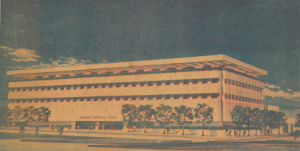
The NCPTT MidCentury Modern Structures Symposium was held in St. Louis across the street from Eero Saarin’s glorious Gateway Arch.
It’s been four years since I launched Barbara A. Campagna/Architecture + Planning, PLLC and while many things have changed, my goal to work on “greening what’s already here” continues to be met, often in places I never expected. Many people are finding new ways to integrate historic preservation and green building practices, which makes my new venture a delightful and intellectually inspiring one. This is blog one of my anniversary week.
Last week I attended a truly fabulous symposium in St. Louis – Mid Century Modern Structures sponsored by NCPTT and the World Monuments Fund. I presented a paper discussing the challenges of preserving Brutalist-style architecture in Buffalo. The title of my paper and this blog is rather ironic because, of course, saving Brutalism is challenging everywhere, not just in Buffalo.
Why is Brutalism one of the most difficult eras to preserve?

One Seneca Tower, built as the Marine Midland Bank Headquarters in 1972, designed by SOM, is one of the least liked buildings in Buffalo.
Questions of authenticity, the use of materials such as concrete panels and concrete block, the construction of new building types like public housing that do not have inherent supporters, and maintaining some of the most energy inefficient buildings ever built are some of the aspects that impact its preservation. This Blog and attached paper will look at a sample of Brutalist icons in Buffalo, New York, which demonstrate the pros and cons of saving these buildings.
Buffalo Modernism
Buffalo has a rich modernist heritage, which is now under siege. Not surprisingly, it is concrete Brutalist style buildings at the forefront of this battle. As a way to counteract misconceptions about modernism, this author taught a seminar last spring in the University at Buffalo School of Architecture & Planning. The semester long project was to document a Buffalo modern for the DOCOMOMO US Registry. Four buildings represent the Brutalist era and their appreciation or lack thereof seems to be related to ownership, building type, site plan, maintenance of material and perception of beauty. Those buildings remaining in the ownership of the original owners have fared much better than those that have not.
The Buffalo Evening News Building, Edward Durell Stone

Rendering of the Buffalo Evening News Headquarters designed by Edward Durell Stone. Image courtesy The Buffalo News.
The Buffalo Evening News Building was designed in 1973 by Edward Durell Stone using both site-cast and precast concrete. The project melded the influences of Buffalo’s heavy Gothic architecture with the purity and minimalism of the International Style. The complex has remained in use as the paper’s headquarters and is in fair condition, although its concrete and flat roof require constant maintenance. There is no current threat, but a better level of appreciation of this restrained yet significant structure is desirable.
Temple Beth Zion, Max Abramovitz
The Temple Beth Zion, designed by Max Abramovitz in 1967, is representative of the Brutalist movement with symbolic intent and material use. Monolithic, rough-face concrete walls with exposed aggregate and fastener holes reference a simplistic and unadorned approach. It received both national and local praise for its beauty and progressive aesthetic stature when it opened. The complex remains a beloved symbol of the congregation and is not threatened.
One Seneca Tower (former HSBC Center), SOM
SOM designed this precast concrete building in 1972 as a bank’s headquarters. At 40 stories, it remains the tallest privately owned building outside of New York City. It has a conflicted relationship with Main Street, which is articulated through a barren tunnel and windswept plazas at the base of the building. Its most recent primary tenant, HSBC, moved out in 2013, leaving the building 95% vacant with its owners in bankruptcy. It is one of the least liked buildings in Buffalo.
The Shoreline Apartments, Paul Rudolph

The Shoreline Apartments, designed by Paul Rudolph 1971-1974, are threatened with partial demolition.
The Shoreline Apartments, a public housing development, was commissioned in 1969. What was ultimately completed in 1974 was considerably reduced in scale from Rudolph’s original scheme. Featuring corduroy concrete block, projecting balconies and enclosed garden courts, the project’s serpentine site plan was meant to create active communal green spaces, but the spaces went unused and the high crime rate over the years has often been attributed to the design rather than poor management.
Still low-income housing, Shoreline is currently threated by the current owners who are proposing demolishing five of the original 32 buildings and replacing them with “Nouveau Victorian fiber cement board suburban rowhouses.” Their reason – the buildings are “ugly,” energy inefficient and encourage crime.
To read the full paper, which will be published in the Proceedings of the symposium later this summer, please click here to read What Makes Preserving Brutalism in Buffalo So Hard?.
And if you’d like to “subscribe” or follow my blog, True Green Cities, please sign up through the “Subscribe” button at the bottom left of this page. You’ll receive a daily recap when new blogs are posted. Or Sign up for the Feed.

